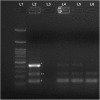Vanishing retinal arterial aneurysms with anti-tubercular treatment in a patient presenting with idiopathic retinal vasculitis, aneurysms, and neuroretinitis
- PMID: 26922651
- PMCID: PMC4769709
- DOI: 10.1186/s12348-016-0074-3
Vanishing retinal arterial aneurysms with anti-tubercular treatment in a patient presenting with idiopathic retinal vasculitis, aneurysms, and neuroretinitis
Abstract
Background: Idiopathic retinal vasculitis, aneurysms, and neuroretinitis (IRVAN) syndrome presents with characteristic clinical manifestations such as aneurysms at arteriolar bifurcations and optic nerve and retinal vascular inflammation. Regression of such features on treatment with anti-tubercular therapy (ATT) combined with corticosteroids has not been reported in literature.
Findings: A 30-year-old female with sudden painless decreased vision in the left eye was referred with a diagnosis of presumed tuberculous retinal vasculitis and a positive tuberculin skin test. Based on the clinical and angiographic features of the right eye, a diagnosis of IRVAN syndrome was made. In the left eye, the patient had vitreous hemorrhage for which pars plana vitrectomy was performed. The vitreous sample was positive for Mycobacterium tuberculosis using multiplex polymerase chain reaction, and the patient was started on standard four-drug ATT and oral corticosteroids. At 6-month follow-up, vanishing of retinal arterial aneurysms was observed.
Conclusions: The pathogenesis of IRVAN syndrome is uncertain. One of the postulates is that the features of arterial aneurysms and other retinal vascular alterations occur secondary to acquired inflammatory reaction. We hypothesize that IRVAN syndrome may be a morphological diagnosis possibly associated with various entities, one of which could be ocular tuberculosis. It may be prudent to rule out intraocular tuberculosis in cases labeled as IRVAN syndrome in an endemic population.
Keywords: Aneurysms; Anti-tubercular therapy; Fluorescein angiography; IRVAN; Intraocular tuberculosis; Polymerase chain reaction; Uveitis.
Figures



References
-
- Karagiannis D, Soumplis V, Georgalas I, Kandarakis A. Ranibizumab for idiopathic retinal vasculitis, aneurysms, and neuroretinitis: favorable results. Eur J Ophthalmol. 2010;20:792–4. - PubMed
LinkOut - more resources
Full Text Sources
Other Literature Sources
Miscellaneous

